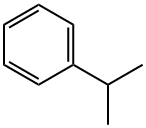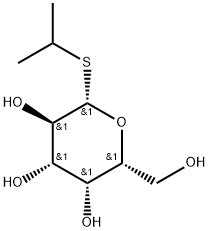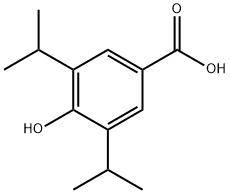Isopropylbenzene standard solution , StandardforGC,>99.5% , 98-82-8
Synonym(s):
Cumene;Isopropylbenzene;Cumene solution;(1-Methylethyl)benzene;2-Phenylpropane
CAS NO.:98-82-8
Empirical Formula: C9H12
Molecular Weight: 120.19
MDL number: MFCD00008881
EINECS: 202-704-5
PRODUCT Properties
| Melting point: | −96 °C(lit.) |
| Boiling point: | 152-154 °C(lit.) |
| Density | 0.864 g/mL at 25 °C(lit.) |
| vapor density | 4.1 (vs air) |
| vapor pressure | 8 mm Hg ( 20 °C) |
| refractive index | n |
| Flash point: | 115 °F |
| storage temp. | 2-8°C |
| solubility | 0.05g/l |
| form | Liquid |
| pka | >14 (Schwarzenbach et al., 1993) |
| color | Clear colorless |
| Odor | Strong, slightly irritant; fragrant; aromatic. |
| Odor Threshold | 0.0084ppm |
| explosive limit | 0.8-6.0%(V) |
| Water Solubility | Soluble in alcohol, ether, acetone, benzene, carbon tetrachloride. Insoluble in water. |
| Merck | 14,2617 |
| BRN | 1236613 |
| Henry's Law Constant | 13.0, 15.3, and 23.9 at 28.0, 35.0, and 46.1 °C, respectively (headspace method, Hansen et al.,
1993) |
| Dielectric constant | 2.4(20℃) |
| Exposure limits | Flammable liquid; flash point (closed cup)
36°C (97°F) (NFPA 1986), 39°C (102°F)
(Merck 1996), 35.5°C (96°F) (Meyer 1989);
vapor pressure 8 torr at 20°C (68°F); vapor
density 4.1 (air=1); the vapor is heavier than
air and may travel a considerable distance
to a nearby ignition source and flash back;
autoignition temperature 425°C (797°F); fire- extinguishing agent: dry chemical, foam, or
CO2; use a water spray to keep fire- exposed
containers cool and to disperse the vapors。 Cumene forms explosive mixtures in the air within the range 0.9–6.5% by volume in air. Cumene may form peroxide on prolonged exposure to air. It should be tested for peroxides before it is subjected to distillation or evaporation。. |
| Stability: | Stable, but may form peroxides in storage if in contact with the air. Test for the presence of peroxides before heating or distilling. Combustible. Incompatible with strong oxidizing agents. |
| InChIKey | RWGFKTVRMDUZSP-UHFFFAOYSA-N |
| LogP | 3.55 at 20℃ |
| Surface tension | 28.21mN/m at 20°C |
| CAS DataBase Reference | 98-82-8(CAS DataBase Reference) |
| IARC | 2B (Vol. 101) 2013 |
| NIST Chemistry Reference | Benzene, (1-methylethyl)-(98-82-8) |
| EPA Substance Registry System | Cumene (98-82-8) |
Description and Uses
Cumene is a common name for isopropylbenzene, an organic
compound. Cumene is a volatile colorless liquid at room
temperature with a characteristic sharp, penetrating, aromatic
odor. It is insoluble in water but is soluble in alcohol and many
other organic solvents. Cumene is structurally a member of the
alkyl aromatic family of hydrocarbons, which also includes
toluene (methylbenzene) and ethylbenzene.Cumene can be
found in crude oil, refined fuels, and is a part of processed highoctane
gasoline.
Cumene is manufactured by reacting benzene with
propylene at elevated temperature and pressure in the presence
of a catalyst. It is considered an environmental pollutant
because it is a natural component of petroleum and is present
in tobacco smoke. Cumene vapor can be absorbed by the respiratory tract. Sufficiently high levels of exposure to cumene
causes central nervous system (CNS) depression leading to
death, internal bleeding of numerous organs, as well as irritation
of the eyes and respiratory system, skin, and mucous
membranes. Cumene is a high production volume chemical.
Around 98% of cumene is used in the production of phenol and its coproduct, acetone, using cumene hydroperoxide as chemical intermediate. However, the demand for cumene is largely dependent on the performance of phenol’s derivatives, which have resulted in healthy growth rates in demand for cumene. It is also used as a starting material in the production of acetophenone, α-methylstyrene, diisopropylbenzene, and dicumylperoxide. Cumene is used as a thinner for paints, lacquers, and enamels. It is also used in the manufacture of acetophenone, methylstyrene, and other chemicals commonly found in home cleaning products. Minor uses of cumene include as a constituent of some petroleum-based solvents, such as naphtha; in gasoline blending diesel fuel and highoctane aviation fuel; and as a raw material for peroxides and oxidation catalysts such as polymerization catalysts for acrylic and polyester-type resins. It is also a good solvent for fats and resins and has been suggested as a replacement for benzene in many of its industrial applications.
Safety
| Symbol(GHS) |     GHS02,GHS07,GHS08,GHS09 |
| Signal word | Danger |
| Hazard statements | H226-H304-H335-H411 |
| Precautionary statements | P210-P233-P240-P273-P301+P310-P331 |
| Hazard Codes | Xn,N,T,F |
| Risk Statements | 10-37-51/53-65-39/23/24/25-23/24/25-11 |
| Safety Statements | 24-37-61-62-45-36/37-16 |
| RIDADR | UN 1918 3/PG 3 |
| OEB | A |
| OEL | TWA: 50 ppm (245 mg/m3) [skin] |
| WGK Germany | 1 |
| RTECS | GR8575000 |
| F | 10 |
| Autoignition Temperature | 797 °F |
| TSCA | Yes |
| HazardClass | 3 |
| PackingGroup | III |
| HS Code | 29027000 |
| Hazardous Substances Data | 98-82-8(Hazardous Substances Data) |
| Toxicity | LD50 orally in rats: 2.91 g/kg (Smyth) |
| IDLA | 900 ppm [10% LEL] |




